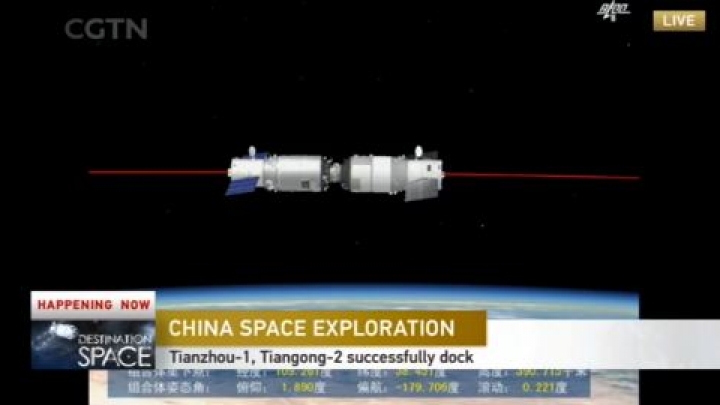China's cargo spacecraft successfully docks with space lab
![Photo taken on April 22, 2017 shows the Tianzhou-1 cargo spacecraft moving towards the orbiting Tiangong-2 space lab for the automated docking on a screen at Beijing Aerospace Control Center in Beijing, capital of China.[Photo: Xinhua/Wang Sijiang]](https://chinaplus.cri.cn/images/201704/22/fa341e65-7c08-b25a-35f3-13cabe01958d.jpg)
Photo taken on April 22, 2017 shows the Tianzhou-1 cargo spacecraft moving towards the orbiting Tiangong-2 space lab for the automated docking on a screen at Beijing Aerospace Control Center in Beijing, capital of China.[Photo: Xinhua/Wang Sijiang]
The Tianzhou-1 cargo spacecraft successfully completed automated docking with the orbiting Tiangong-2 space lab at 12:23 p.m. Saturday, according to Beijing Aerospace Control Center.
It is the first docking between the spacecraft and space lab.
![Photo taken on April 22, 2017 shows the Tianzhou-1 cargo spacecraft moving towards the orbiting Tiangong-2 space lab for the automated docking on a screen at Beijing Aerospace Control Center in Beijing, capital of China. [Photo: Xinhua/Wang Sijiang]](https://chinaplus.cri.cn/images/201704/22/f3bb768b-e9db-34fe-002c-7445dac2074a.jpg)
Photo taken on April 22, 2017 shows the Tianzhou-1 cargo spacecraft moving towards the orbiting Tiangong-2 space lab for the automated docking on a screen at Beijing Aerospace Control Center in Beijing, capital of China. [Photo: Xinhua/Wang Sijiang]
Tianzhou-1, China's first cargo spacecraft, which was launched Thursday evening from Wenchang Space Launch Center in south China's Hainan Province, began to approach Tiangong-2 automatically at 10:02 a.m. Saturday and made contact with the space lab at 12:16 p.m.
The Tianzhou-1 cargo ship and Tiangong-2 space lab will have another two dockings.
The second docking will be conducted from a different direction, which aims to test the ability of the cargo ship to dock with a future space station from different directions.
In the third docking, Tianzhou-1 will use fast-docking technology. It normally takes about two days to dock, while fast docking will take only six hours.
![Technical personnel work at Beijing Aerospace Control Center to monitor the automated docking between Tianzhou-1 cargo spacecraft and Tiangong-2 space lab in Beijing, capital of China, April 22, 2017. [Photo: Xinhua/Yu Tao]](https://chinaplus.cri.cn/images/201704/22/8be7d59b-9e42-7b82-33dd-8cfb747b5b6a.jpg)
Technical personnel work at Beijing Aerospace Control Center to monitor the automated docking between Tianzhou-1 cargo spacecraft and Tiangong-2 space lab in Beijing, capital of China, April 22, 2017. [Photo: Xinhua/Yu Tao]
Refueling will also be conducted, a process with 29 steps that takes several days.
Tiangong-2, which went into space on Sept. 15, 2016, is China's first space lab "in the strict sense" and a key step in building a permanent space station.
Cargo ships play a crucial role maintaining a space station and carrying supplies and fuel into orbit.


